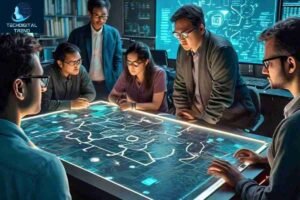Table of Contents
ToggleReinforcement Learning
A key idea in machine learning is reinforcement learning, which teaches agents how to make judgments in unpredictable, complicated situations. This methodology has a wide range of applications in gaming, robotics, and recommendation systems, among other domains. We’ll go into the field of reinforcement learning in this post and examine its main ideas, workings, and applications.
How does Reinforcement Learning work?
Agents may be taught how to interact with their environment to maximize rewards using a type of machine learning called reinforcement learning. By drawing lessons from its past, the agent modifies its behavior to achieve the desired outcome. In this process, trial and error is involved, and the agent gets feedback in the form of rewards or penalties.
Markov Decision Processes (MDPs)
MDPs are a mathematical framework used to model decision-making processes in situations where outcomes are uncertain. They consist of states, actions, transitions, and rewards, providing a structured approach to solving learning problems.
Deep Reinforcement Learning
Deep reinforcement learning combines the power of deep learning with reinforcement , enabling agents to learn complex behaviors and make decisions in high-dimensional state spaces. This approach has led to significant breakthroughs in various applications, including game playing and robotics.
Q-Learning
Q-learning is a popular reinforcement learning algorithm that involves learning the value of actions in different states. It updates the Q-table based on the agent’s experiences, enabling it to make optimal decisions in the long run.
Policy Gradient Methods
Policy gradient methods are a class of reinforcement learning algorithms that focus on directly optimizing the policy, rather than learning the value function. They have been successfully applied to various tasks, including robotics and game playing.
Actor-Critic Methods
Actor-critic methods combine the benefits of policy gradient methods and value-based methods, enabling agents to learn both the policy and the value function simultaneously.
Applications of Reinforcement Learning
Numerous areas have found uses for reinforcements learning, such as:
- Robotics: Reinforcement learning can be used to train robots to perform complex tasks, such as grasping and manipulation.
- Game Playing: Reinforcement learning has been used to train agents to play games like Go, Poker, and Video Games.
- Recommendation Systems: Reinforcements learning can be used to personalize recommendations for users based on their behavior.
- Finance: Trading techniques and portfolio management may be optimized by the application of reinforcement learn.
- Healthcare: Reinforcement learn can be used to optimize treatment strategies and drug discovery.
Real-World Examples of Reinforcement Learning
- AlphaGo: AlphaGo is a computer program that uses reinforcement learning to play Go. It defeated a human world champion in 2016.
- DeepMind’s AlphaFold: AlphaFold is a computer program that uses reinforcement learning to predict protein structures. It has been used to predict the structures of proteins related to diseases such as Alzheimer’s and Parkinson’s.
- Robot Learning: Reinforcement learning has been used to train robots to perform complex tasks such as grasping and manipulation.
Challenges and Limitations of Learning
- In order to maximize rewards, the agent must strike a balance between discovering new activities and utilizing what they now know.
- Delayed Rewards: The agent may receive rewards after a long delay, making it challenging to learn the optimal policy.
- High-Dimensional State Spaces: The agent must learn to make decisions in high-dimensional state spaces, which can be challenging.
- Safety and Robustness: The agent must learn to make decisions that are safe and robust, avoiding harmful or undesirable outcomes.
Future of Reinforcement Learning
- Reinforcements learning is a rapidly evolving field, with new applications and advancements emerging regularly. Some of the future directions of reinforcement include:
- Multi-Agent Reinforcement : Training multiple agents to work together to achieve a common goal.
- Transfer Learning: Using knowledge gained from one task to improve performance on another related task.
- Explainability and Transparency: Developing methods to explain and interpret the decisions made by reinforcements learning agents.
Conclusion:
Reinforcement learning is a fundamental concept in machine learning that involves training agents to make decisions in complex, uncertain environments. By understanding the key concepts, algorithms, and applications of reinforcement learning, you can unlock the potential of AI development. Remember, reinforcements learning is a continuous learning process, and with persistence and dedication, you can master this crucial aspect of machine learning.
With the ability to train agents to make decisions in complex environments, reinforcement has numerous applications in various fields, including robotics, game playing, and recommendation systems. Its potential to revolutionize industries and improve decision-making processes makes it an exciting and rapidly evolving field.
Whether you’re a seasoned machine learning practitioner or just starting your journey, reinforcement is an essential concept to grasp. By applying the concepts and algorithms discussed in this article, you can develop innovative solutions to real-world problems and unlock the full potential of AI development.
Open this link: Tap to here















